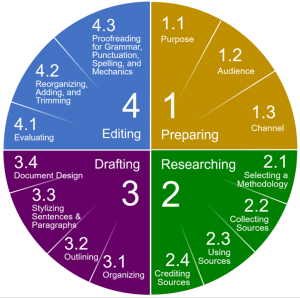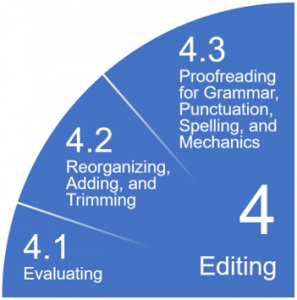Chapter 5: The Writing Process 4: Editing
Learning Objectives
- ENL1813 Course Learning Requirement 1: Plan, write, revise, and edit short documents and messages that are organized, complete, and tailored to specific audiences.
-
- Recognize and use basic patterns of standard English (ENL1813 CLRs H1.3, I1.3, M1.4, S1.4, T1.3)
- Incorporate elements of business writing style (ENL1813 CLR B1.4)
- Apply proper use of sentence structure, grammar, and punctuation (ENL1813 CLR B1.5)
- Craft unified and coherent sentences and paragraphs (ENL1813 CLR A1.3)
- Use a systematic approach to edit, revise, and proofread (ENL1813 CLR R5.3)
- Edit and proofread documents to eliminate errors (ENL1813 CLRs H1.5, I1.5, M1.6, S1.6, T1.5)
- Revise documents to improve clarity, correctness, and coherence (ENL1813 CLRs G1.5, P1.4, R7.4)
Whatever you do, don’t quit now! Self-correction is an essential part of the writing process, one that students or professionals skip at their peril. Say you’ve just dashed off a quick email. Glancing back to ensure that it’s correct in terms of its grammar, punctuation, spelling, and mechanics helps you avoid confusing your reader or embarrassing yourself. Those errors can be like stains on your shirt or rips in your uniform: they give the impression that you’re incompetent or uncaring—qualities no employers respect because it suggests a lack of attention to detail.
Always keep in mind that people generalize to equate the quality of your writing with the quality of your work. Because readers tend to be judgmental, they may even draw bigger conclusions about your level of education, work ethic, and overall professionalism from even a small writing sample. Especially with résumés and cover letters where your words are the first impression employers have of you, employers are judgmental about your writing because customers can be. Employers don’t want you to represent their company to customers in a way that makes it look like the whole organization does shoddy, amateur work.
The final stage of the writing process is thus managing your readers’ impressions by editing your draft from beginning to end. This involves first returning to your headspace at the start of the writing process and assessing where your document is in relation to the purpose you set out to achieve for it (see Step 1.1 in §2.1 above). When you get a sense of how far your document is from achieving that primary purpose, you realize what needs to be done to close that gap—what you need to add, rewrite, delete, and improve. Your next move is a two-step editing process of substantial revisions and proof-editing. The order of these is crucial to avoid wasting time. You wouldn’t proofread for minor grammatical errors before substantial revisions because you may end up just deleting altogether paragraphs that you meticulously proofread with a fine-tooth comb. We’ll therefore divide the process into lessons you can apply to the editing process in the following order:
- 5.1: Substantial Revisions
- 5.2: Proofreading for Grammar
- 5.3: Proofreading for Punctuation
- 5.4: Proofreading for Spelling
- 5.5: Proofreading for Mechanics


Figure 5: The four-stage writing process and Stage 4 Breakdown

